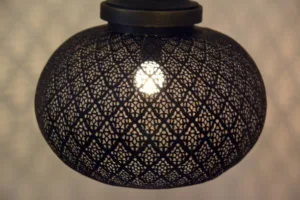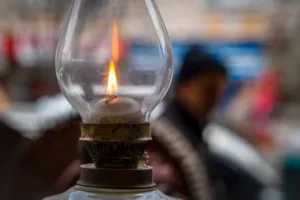Coal oil lamp:

For centuries, humanity grappled with darkness after sunset. Fire provided a flickering glow, but it wasn’t ideal for everyday tasks. Then came the coal oil lamp, a game-changer that revolutionised how we illuminated our lives. Let’s delve into the captivating history of these lamps, exploring their rise to prominence, the challenges they faced, and their lasting legacy.
The Birth of Coal Oil Lamps (18th–19th Centuries)
The story of coal oil lamps began in the late 18th century with a substance called “coal oil.” This byproduct of coal, gas and tar offered a glimmer of hope for brighter nights. However, early iterations burned with a sooty flame, relegating them to outdoor use. Whale oil, which burned cleaner, dominated indoor lighting for a while.
The tides turned in 1850 when Scottish chemist James Young developed a process to refine coal oil, making it suitable for indoor illumination. This innovation paved the way for the widespread adoption of coal oil lamps, forever altering domestic life.
Read More: How Bladeless Wind Turbines and Solar Windows Work
A Brighter Future: Coal Oil Lamps’ Benefits and Applications

Coal oil lamps offered a multitude of benefits over traditional lighting methods, including:
i. Brighter Illumination: Compared to candles and firelights, coal-oil lamps provided significantly brighter light, making evening activities like reading and writing much easier.
ii. Portability: Unlike fireplaces, coal oil lamps were portable, allowing for flexible lighting arrangements within homes or outdoors.
iii. Affordability: Kerosene, a more refined version of coal oil, became the primary fuel source. It was readily available and relatively inexpensive compared to other options.
iv. Safety: Coal oil lamps, especially later models with enclosed burners, were safer than open flames, reducing the risk of fire accidents.
Beyond Homes: Coal Oil Lamps Light Up the World
The influence of coal oil lamps extended far beyond domestic settings. They became ubiquitous in a variety of applications.
i. Commercial Lighting: Shops, stores, and restaurants heavily relied on coal-oil lamps to illuminate their spaces before the advent of electricity.
ii. Transportation: Ships, carriages, and early automobiles used coal oil lamps for navigation and safety during nighttime journeys.
iii. Industrial Lighting: Factories and workshops adopted coal oil lamps to keep operations running smoothly through the night.
Read More: How Natural Gas is Losing to Renewable Energy
The Evolution of Coal Oil Lamps: Challenges and Advancements

Despite their numerous advantages, coal-oil lamps weren’t without drawbacks.
i. Soot and Odour: Even with refined kerosene, lamps could emit soot and unpleasant odours, requiring regular cleaning and ventilation.
ii. Fire Risk: Although safer than open flames, improper handling or lamp malfunctions could still lead to fires.
iii. Limited Fuel Efficiency: Compared to modern lighting solutions, coal oil lamps require frequent refuelling, adding a maintenance burden.
Exploring Advancements in Coal Oil Lamp Technology
These challenges spurred continuous advancements in coal oil lamp technology.
i. Improved Burner Designs: New burner designs enhance fuel efficiency and reduce soot production.
ii. Mantle Lamps: The late 19th century saw the introduction of incandescent mantles, which significantly increased light output.
iii. Flat-wick lamps: These lamps featured a flat wick that drew up the kerosene and produced a steady flame. They were relatively inexpensive and easy to use, making them popular for everyday lighting in homes and businesses.
iv. Round-wick lamps: lamps with cylindrical wicks that are fitted with metal chimneys. This design ensured a more efficient burn, resulting in a brighter light. Additionally, the chimney helped regulate airflow and reduce smoke.
v. Safety Features: For outdoor use, pressure lanterns and enclosed globe lamps provide greater safety and weather resistance.
Read More: Unveiling the Latest Advances in Solar Technology
A Legacy of Light: Coal Oil Lamps in the Modern World

Electric lighting was invented in the late 19th century and eventually outperformed coal-oil lamps for everyday use. However, these lamps haven’t faded entirely. Here’s how they remain relevant today:
i. Decorative Accents: Vintage coal oil lamps are prized for their aesthetic appeal, adding a touch of nostalgia and rustic charm to homes and businesses.
ii. Emergency Lighting: Coal-oil lamps provide a reliable source of light during power outages, making them valuable for emergency preparedness kits.
iii. Off-the-Grid Living: For those living off the grid or in remote locations, coal oil lamps offer a dependable lighting solution.
iv. Camping and Outdoor Activities: Modern kerosene lanterns are popular choices for camping trips, providing bright light and a source of heat for outdoor enthusiasts.
v. Ambiance and Warmth: The soft glow of a coal oil lamp creates a unique ambience that electric lights struggle to replicate. It provides a warm, inviting atmosphere, perfect for relaxation and storytelling.
vi. Emergency Preparedness: In areas prone to power outages, coal oil lamps offer a reliable source of light during emergencies. Their simple design and fuel efficiency make them valuable tools for off-the-grid living or disaster preparedness.
vii. Collectible Beauty: Intricate designs, historical significance, and enduring craftsmanship are what make antique coal oil lamps so desirable to collectors.
Read More: Unveiling the Truth About Natural Gas Greenwashing
Conclusion:
Coal-oil lamps illuminate more than just rooms; they illuminate a bygone era of human ingenuity. From their humble beginnings to their lasting legacy, these lamps represent a significant chapter in the history of lighting. As we embrace modern lighting technologies, the warmth and historical significance of coal oil lamps continue to hold a special place in our hearts and homes.








